The B2B data landscape has changed — and marketing is changing with it. Account-based marketing – fueled by new fit, intent, and engagement data sources — is rapidly becoming the strategy of choice for modern marketers looking to get a leg up on the competition.
And it’s the savvy marketers who can both acquire and operationalize accurate fit, intent, and engagement data from multiple sources at an account level today who will get promotions tomorrow.
But first… what is account-based marketing?
Account-based marketing is a focused approach to B2B marketing in which marketing and sales teams work together to target best-fit accounts and turn them into customers.
While this focused, “white-glove” approach to acquiring spotlight accounts isn’t new — the data available to savvy marketers tasked with attracting those accounts, is new. If you’re beginning with ABM, you might be struggling to operationalize this data at scale in an ABM framework.
Today’s article aims to help solve that issue by providing three steps to scaling a modern ABM strategy.
1) Understanding fit through your TAM and ICP
Before you get started with any ABM strategy, it’s important to understand the modern, sophisticated methods available to segment your total addressable market (TAM) with the factors that make up your ideal customer profile (ICP).
What does TAM mean? Your total addressable market comprises all the accounts (or companies) that you could possibly ever sell to. This is how much revenue you could potentially make from selling your existing set of products and services.
The interesting fact about your TAM is that it is finite — meaning there is a limit to the amount of revenue you could make year over year. This is critical as you consider how to scale your ABM program to land and expand within those accounts in a budget-conscious manner.
An ICP is a criteria-based description of the company that’s the best fit for your offering. This can include firmographics, like company size and industry, technographics, like different marketing technologies on the website, and more. Firmographics are essentially the business equivalent of demographics, while technographics is essentially your tech stack.
Your ICP should focus on relevant characteristics of your target accounts, such as:
- Industry/vertical
- Geography
- Employee headcount — companywide
- Technology they use and within key departments (like marketing automation)
- Size of their customer base
- Annual revenue
- Level of organizational or technological maturity
- Budget
When it comes to ABM, buyer personas play second fiddle to ICP. While they are still important, don’t confuse them with your ICP. In ABM, buyer personas are only activated after you begin engaging contacts within an account as you work towards reaching the entire buying committee.
Ways to get started
If you’re an established company, an easy way to begin is to look at all the accounts who have been customers for two or more deal cycles and look for trends among the criteria above. Terminus contracts, for example, are renewed annually, so we looked at accounts which have been customers for two years.
If you’re still growing, you will need to lean heavier into market research or a data enrichment service to fill in the criteria for a high-fit account.
Your output should look something like this:
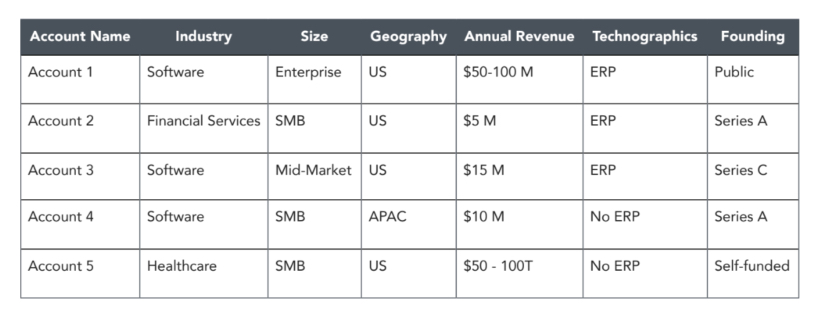
From here, you can see that this company’s best-fit accounts are typically located in the US, have funding, have an enterprise resource planning solution (ERP), with annual revenue of 5+ million. Conduct this exercise yourself by pulling a list from your CRM of your best customers and determining the criteria that bonds them.
If your data is incomplete, this may require using a data enrichment service like DiscoverOrg or Datafox. Modern ABM platforms offer data enrichment as part of their solution and can sync with your CRM to enable to you determine your ICP.
Understanding this will allow your sales and marketing teams to focus exclusively on these accounts — who are likely to renew year over year — as opposed to blasting campaigns to anyone who might complete a form.
From here, you can start building an ABM program based on the criteria currently in your CRM and start discovering ways to unearth net-new accounts that match as well.
2) Tiering accounts using fit, intent, engagement data
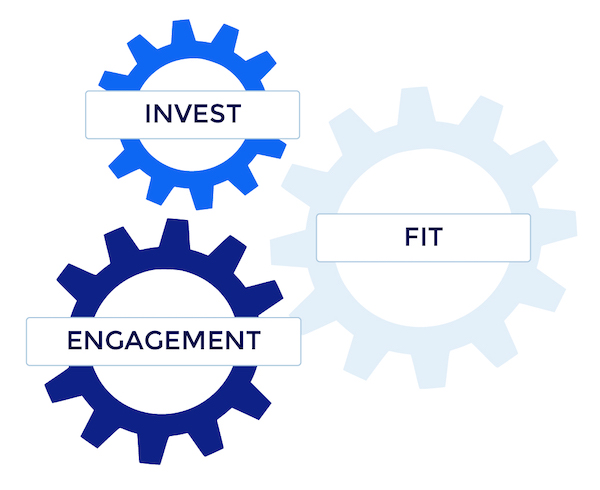
Once you have a clear understanding of your TAM and ICP, layer in intent and engagement data to elevate the accounts demonstrating purchase behavior.
A few providers of intent data include Bombora and G2 Crowd.
Bombora uses a GDPR and CCPA-compliant data co-op and machine learning to alert you when a company is demonstrating behavioral signals matching buying intent. This includes the type of content consumed and if they scrolled to the bottom at a speed indicating reading.
G2, a product review website, also offers a form of intent data. G2 tracks when a visitor searches for reviews of your company or your competitors and can notify you when an account is researching a specific product category.
Another type of intent includes bidstream, which uses an ad pixel to scrape websites for keywords, but this type of intent is not GDPR or CCPA-compliant and only tracks page visits, not consumer behavior.
For your intent and engagement to be useful, you should look for providers leveraging machine learning to determine whether a consumer’s behavior is statistically related to purchasing behavior.
Some platforms deliver only cumulative data, while other providers notify you when an account is “surging” in intent or engagement compared to an average benchmark.
This means that your sales and marketing teams are highly focused on accounts that are actively in-market and considering your product, which also represents a large deal.
If you are tracking engagement by the lead level, you may end up wasting time on a lead from a poor fit account rather than dedicating more time and resources to a high fit account.
Once you know how many accounts you’ll be targeting based on intent and engagement data, you can determine the menu of marketing programs that each tier will receive. This will help you determine which accounts you are going after right now:
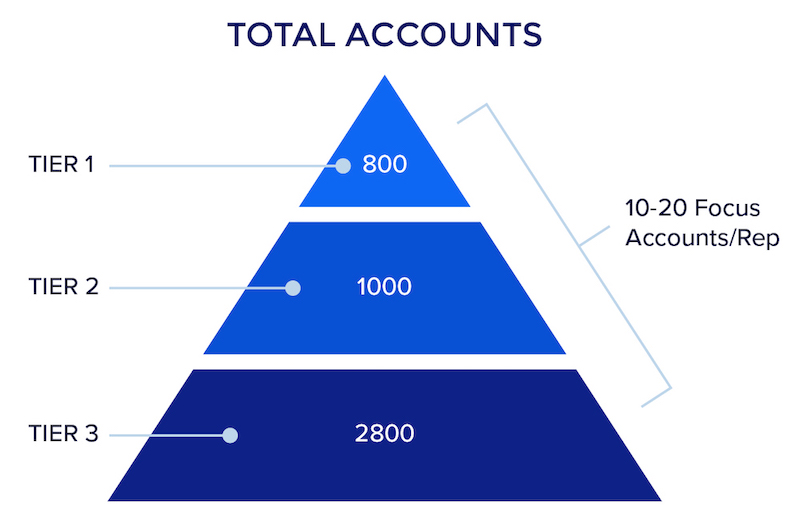
4 Things to consider
- Most organizations begin an ABM program with 100 to 1,000, depending on their size. You don’t need to limit your strategy to those amounts, though. Read how Invoca ran a tiered ABM program to 4,500 accounts.
- The duration of your ABM program might be a month, a quarter, or even a year depending on your sales cycle.
- Most successful ABM strategies begin with a small elite team of your best salespeople who can demonstrate early success.
- Any ABM platform you commit to needs to have deep CRM integrations to deliver information to sales when and where they need it.
Using the Goldilocks method
Start by segmenting and tiering your accounts based on firmographics, fit, engagement, and opportunity size. Determine the volume of accounts based on your sales structure, deal cycle length, and account consumption metrics. Your goal is to create cohorts that merit the “just right” amount of attention and budget.
“Just right” tier 1 accounts
High-Fit, Large ACV, Recent Intent, Recent Engagement
The “just right” accounts are those that get the highest amount of marketing support and budget with a forecastable close date. These are accounts that should match your ICP that are also demonstrating recent intent and engagement at the account-level.
With 78% of sales going to the first responder to the table, these are accounts that need the most attention now.
These accounts often receive 1-to-1 marketing programs which include thought-leadership opportunities, bespoke pieces of content, special event invitations, highly-personalized, dynamic post-click landing pages, and perhaps even a dedicated staff member focused exclusively on them:
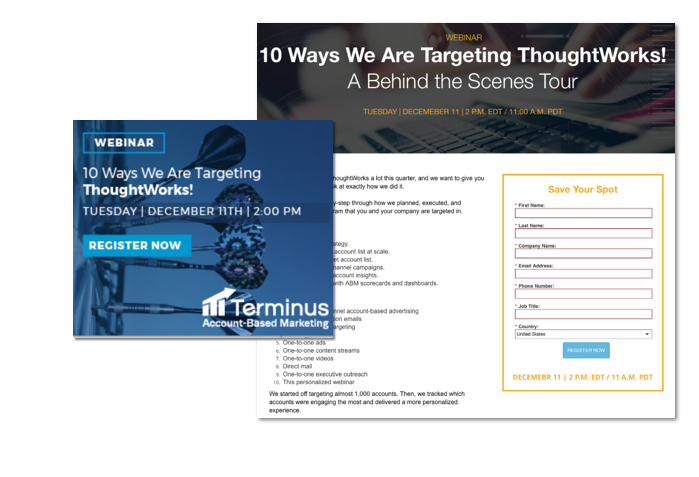
“Too big” tier 2 accounts
High-Fit, Recent Intent, No Engagement, Medium ACV
The “too big” account lists represent a higher volume of accounts showing recent intent that would require too much bandwidth to support 1-to-1 campaigns to engage fully. While these companies might not match 100% of your ICP, they should still be successful with your brand (which they haven’t engaged with yet).
Your goal with these accounts is to deliver your message to account and hopefully engage a few members of the buying committee to drive more engagement. They might receive 1-to-1 account-based ads but be driven to a generic landing page, or receive messaging based on intent data but generic marketing content.
“Too small” tier 3 accounts
High-Fit, No Intent, No Engagement, Smaller ACV
The “too small” accounts represent accounts that with ACVs that are too small to warrant hyper-personalized or expensive campaigns and receive modest efforts. While they are still high-fit, they have not shown intent or engagement, meaning sales will be climbing uphill to generate any response.
These might receive a blend of demand gen programs and “always-on” account-based advertisements with generalized messaging to warm the accounts up before the SDR reaches out.
These are a few examples of how you might tier your accounts, but this will depend on the size of your marketing and sales teams and your sales cycle.
3. Make your ABM program modular
We’ve all heard that sales and marketing alignment is critical to ABM success, but this is too complicated to achieve unless you put in a simple workflow where your sales and marketing teams live: your CRM.
To drive alignment, build a modular menu of marketing programs that sales can checkmark and marketing can execute. These should be approved before your campaigns are launched and determined by their tier. Each tier gets its own menu of action items, which sales can “order” via a checkbox. Think “dim sum” but make it ABM.
This can include direct mail, dimensional mailers like popcorn or ice cream, bespoke display creative, custom content, etc. All sales has to do is request via a few checkboxes the different menu items that are allowed for that particular tier, and marketing will execute on them in a timely fashion.
Sendoso offers a multitude of options for dimensional mailers that marketing can approve and even set a budget for. Read Terminus’ ABM case study to see how Thomson Reuters achieved a 95% win rate by tiering their target accounts.
Finalizing your ABM strategy
By leveraging the new B2B data landscape, marketers can get smarter about which accounts to target and build deeply creative and personalized multi-channel programs to engage them right when they are in-market for your offering.
Traditional marketing programs tend to hand off the account to sales and deactivate their outbound programs when they should be increasing them.
In ABM, as an account increases in engagement and begins demonstrating intent, your sales and marketing teams should work in lockstep to open more channels to accelerate your pipeline and increase the likelihood of the deal closing.
According a report from Gartner, the further down the funnel an account gets, the more marketing channels they should receive:
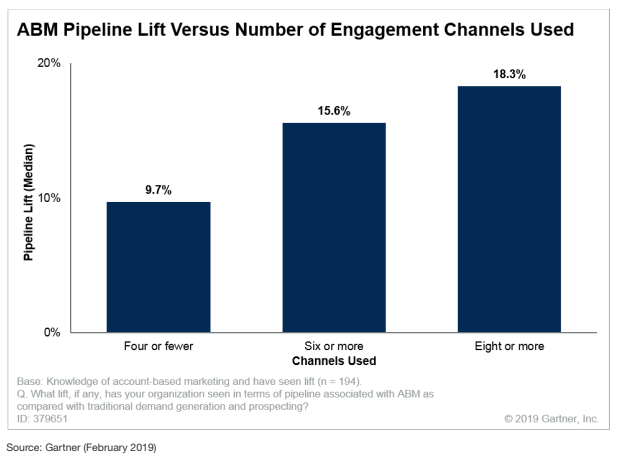
This is why it is critical to tier your accounts by fit, engagement, and intent so that you can commit to building a menu of programs that is easily executable and appropriate for the account.
Combining these approaches can help you build a scalable model which you can expand as your pipeline grows and you hire more talent.
